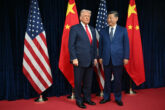September 07, 2018
Beyond Defining a ‘Free and Open Indo-Pacific’
Nearly one year in to the United States, Japan, Australia, and India’s collective pursuit of a “Free and Open Indo-Pacific,” broad misunderstandings of the policy’s intentions and objectives endure. These hyper-analytic concerns are misguided and limit experts’ capacity to evaluate tangible, fact-based shifts in regional powers’ Indo-Pacific policy.
Despite robust evidence to the contrary, some continue to insist that the free and open Indo-Pacific (FOIP) represents an anti-China alliance or a sophisticated U.S.-led containment strategy. This analysis overlooks the regionally-driven nature of the strategy, which was first announced by Japanese Prime Minister Shinzo Abe in August 2016. Furthermore, Australia began using the “Indo-Pacific” construct in official government documents as early as 2013. India’s “Act East” policy, which is a foundational element of its “free, open, and inclusive” vision for the Indo-Pacific region, was initially unveiled in 2014.
Perhaps pundits’ confusion can be attributed to the absence of a single coherent document from Quad countries defining what FOIP actually is. But such a document would actually erode the strength of a truly “free and open Indo-Pacific” by constraining each state from shaping their own policy over time in the ways that support its national interests. A common public document would also diminish the inclusivity Indian Prime Minister Narendra Modi so aptly stresses and limit ASEAN’s ability to play a central role.
This is not to say that Indo-Pacific states should be content to develop their own strategies in complete isolation. To the contrary, countries throughout the region interested in the maintenance of a free and open order should develop a common operating picture at the government-to-government level for the Indo-Pacific and its future. In the past few months, onlookers have seen a lot of progress on this front — the overwhelming congruities in the United States, Australia, Japan, and India’s respective strategies are indicative of this. However, instead of strategic consultations being a “one-off” event in preparation for a strategic review, states should institutionalize and regularize these contacts to ensure that one another’s insights are enriching allies’ and partners’ approaches.
Nearly a year after the roll-out of the U.S. Free and Open Indo-Pacific Strategy, it is time to shift away from discussing what FOIP is or isn’t, and instead focus on indicators to gauge success. Unfortunately for policymakers, expectations among the expert community and the region are high, and it will require concrete actions, rather than rhetoric, to interrupt China’s narrative of the inextricable U.S. decline and withdrawal from the Pacific theater.
Read the Full Article at The DiplomatThe Diplomat
More from CNAS
-
North Korea Reveals Troop Dispatch to Russia amid U.S.-South Korea Policy Talks
North Korea has confirmed for the first time that its troops are operating in Russia, and it is preparing to rewrite its party charter with the possibility of officially namin...
By Dr. Go Myong-Hyun
-
Chinese Maker of Bitcoin-Mining Machines Is a Security Threat, Says Expert
Bloomberg News reports that a Chinese manufacturer, Bitmain Technologies Ltd, that sells most of the world’s Bitcoin-mining machines — including 16,000 of them to a venture ba...
By David Feith
-
Indo-Pacific Security / Energy, Economics & Security
North Korea’s Provocations, Power Plays, and Shifting AlliancesTensions on the Korean Peninsula have reached a new and dangerous threshold. President Lee Jae Myung is warning of a real risk of accidental military clashes, as the situation...
By Dr. Go Myong-Hyun
-
Indo-Pacific Security / Energy, Economics & Security
How to Win the Economic War with ChinaTrump's approach to China has run aground, giving Beijing unprecedented advantage in the economic conflict....
By Edward Fishman & Julian Gewirtz



